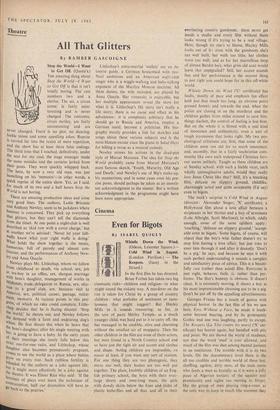THE purchase by the National Gallery of a landscape with
figures widely and reasonably believed to be by Giorgione has attracted less attention than it deserves, far less, for in- stance, than the almost simul- taneous purchase of two not particularly important late Renoirs. It is argu- able that Renoir and Giorgione are artists of equal stature, although no one could claim that Renoir broke as much new ground or exerted such a profound influence upon the course of European painting. But while the purchase of a Renoir, or indeed of any Impressionist or Post- Impressionist painter, is still a realisable possibi- lity for any museum with sufficient funds, it takes more than just money to secure a Giorgione. Only three paintings attributable to him now re- main in private hands, and of these one is a small fragment, one at least as close to Titian as to Giorgione, and the third partly (some would say completely) the work of his follower, Sebastiano del Piombo. Even if it cannot be proved by docu- ments that the National Gallery picture is by Giorgione it is so close in spirit and technique to the Vienna Three Philosophers and the Venice Tempesta, both of them undisputed originals, that only the most pedantic and cautious purist would abstain from endorsing the attribution. He would however be forced to admit that the Gallery has acquired a painting which is not only extraordinarily beautiful but representative of Giorgione's -revolutionary concept of figures in a landscape; in short, a landmark in European art.
Once a revolution has succeeded, it is hard, particularly after a lapse of centuries, to ap- preciate its importance. Pioneers like Giorgione and Caravaggio were, in their day, as daringly original as Picasso or Matisse in ours. But we are so far removed from them in feeling as well as time that if we recognise their originality at all, we take it for granted. It is of no interest to the average gallery visitor that they happened to be the first to paint in a style which countless others imitated or adapte', to their own needs. What's it matter, they argue, these questions of date and attribution are for art historians to amuse themselves with—an attitude, by the way, which they would never dream of adopting to- wards twentieth-century painting. If they were to find one of the Tate Gallery's Derains labelled Vlaminck they would be properly shocked, be-. cause it would display not so much carelessness as a failure on the part of the gallery staff to understand the personality of either artist. They would also hesitate to dismiss as mere hair-split- ting such a vexed problem as who invented Cubism, Braque or Picasso. But when it comes to the Old Masters, the public appears to believe that knowledge is a positive obstacle to enjoy- ment.
Of all Giorgione's contributions to art, the most important was the landscape of mood. Never, admittedly, a pure landscape, but one in which the figures are important only for what they contribute to the atmosphere of the scene itself. Attempts have been made to identify the subjects of the Three Philosophers, the Tempesta, and the National Gallery's new picture, but never with any high degree of plausibility. In the case of the Tempesta, there probably was no subject. X-ray photographs show that Giorgione altered the number and placing of the dramatis personae as the work progressed.
Although the National Gallery picture con- tains the figures of St. George and St. Jerome, their role in the composition is considerably less crucial than that of the unidentifiable youth and old man seated in the middle foreground. These two tranquil pastoral figures embody the spirit of the landscape around them, concentrating in their calm, relaxed silhouettes and the subdued but luxurious tints of their costumes the Arcadian peacefulness of a summer evening on the Veneto. The immediate pictorial ancestor of this picture is the Allegory of the Tree of Life by Giorgione's master Giovanni Bellini, but in that exquisite union of figure and landscape the subject is still of paramount importance. In the NG composi- tion there is still a trace of the old tradition in the presence of the two saints, but they might just as well be figures from classical mythology or some Renaissance romance. This type of composition looks forward to the idylls of Titian, Rubens, Claude and Watteau. It may even be claimed, with the Tempesta, as the earliest prototype of the earthly paradises of Renoir, Cezanne and Matisse. Altogether, the National Gallery 'could scarcely have acquired a picture combining beauty and historical importance to such a degree. The fact that it cost around a quarter as much as the two new Renoirs is a sad com- mentary on current aesthetic and commercial values.
BOOKS
Lords of the Shambles BY JAMES CAMERON



































 Previous page
Previous page